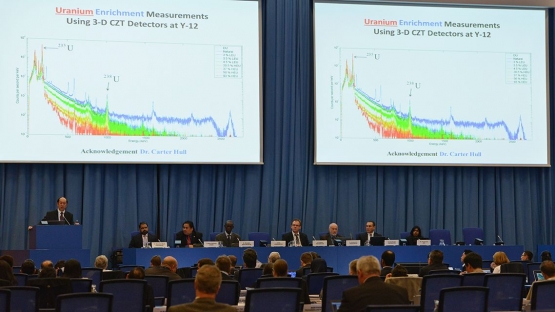Advances in gamma-ray spectrometry, portable hand-held detectors, thermal and 3D digital neutron imaging, extra sensitive mobile and back-pack radiation detectors are fast becoming ‘must-have’ apparatus in global efforts to strengthen nuclear security. Participants learned about such state-of-the-art radiation detection instruments at a meeting at IAEA headquarters last week.
“Our collective task here is to enhance global nuclear security by improving the use, performance, specification and design of radiation detection instruments,” said La Fonda Sutton-Burke, the meeting’s president and Director of the Non-Intrusive Inspection Division at the United States Customs and Border Protection. “By equipping our front line officers with the most appropriate instruments to carry out their detection missions, we can increase the likelihood of detection of illicit trafficking in nuclear and other radioactive materials.”
Customs officers, border guard agencies, regulatory bodies, scientists and emergency response personnel from 53 IAEA Member States were among the participants at the meeting.
Nuclear security capabilities need constant improvement to keep a step ahead of criminals. This requires research and development to manufacture durable, effective detection tools based on precise technical and functional specifications that will result in powerful instruments.
Knowledge sharing, training and lifecycle costs are also important elements when developing these highly sophisticated screening and monitoring tools.
Detect to protect
Participants shared information on the steps taken in their respective countries to detect illicit trafficking in nuclear and other radioactive materials to protect against nuclear terrorism and how improvements in specifications for instruments and research could improve those efforts.
The use of radiation detection devices contributes to building public confidence in efforts to protect the population from exposure. In this context, István R. Almási, a professor from the Hungarian Academy of Sciences, spoke about the latest developments in detection instrumentation used to cover large ranges such as airports and other commercial areas. These highly sensitive, durable and advanced instruments can reveal illicit trafficking, prevent sabotage and can also conduct long-distance checks to detect the illegal transport of radioactive or nuclear material, he said.
Detailed information about highly advanced detection equipment capable of penetrating through shields of dense material to conceal radioactive or nuclear material was also discussed.
The focus of intensive research by companies engaged in further improving and refining these specialised detectors is to meet any possible radiological or nuclear threat by providing precise real-time data and information to a central command and control centre.
Maria Teresa Salabit from the Philippine Nuclear Research Institute drew attention to the importance of equipment maintenance and repair, and how detector design and location could improve security operations. Instrumentation needs regular calibration prior to being used or installed, she said. Instruments must also be able to work in harsh environments – high temperatures, high humidity and heavy rain.
The meeting on radiation detection instruments for nuclear security was hosted at the IAEA headquarters from 4 to 8 April 2016. An exhibition and demonstration on the latest available radiation detectors and systems was also held on the sidelines of the meeting.
By equipping our front line officers with the most appropriate instruments to carry out their detection missions, we can increase the likelihood of detection of illicit trafficking in nuclear and other radioactive materials.



